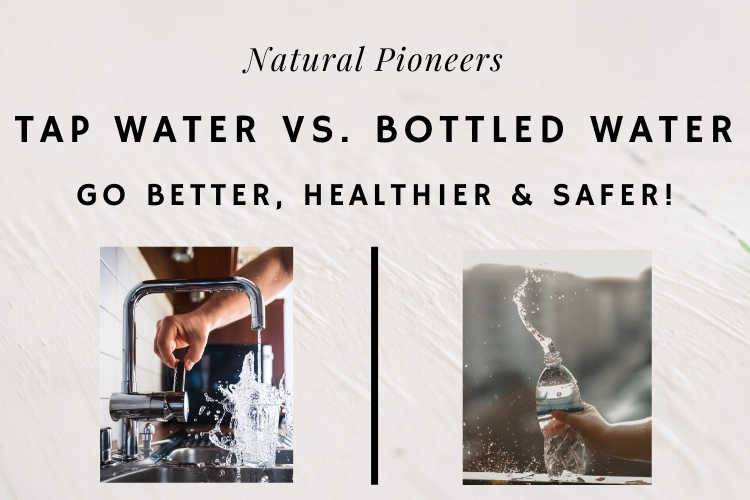
While the government claims to provide safe drinking water through tap, bottled water companies argue to provide the safer water. This article will clear up all confusion and provide you with a simple, yet natural water solution that meets all your needs.
The number of contaminants is smaller in bottled water. Consequently, bottled water is safer than tap water. The more minerals, the healthier the water. Bottled spring or mineral water are healthiest, containing high amounts of minerals. For taste, studies prove high-mineral water tastes best.
Let’s dive into the must-knows when choosing a water for your home.
1. Tap Water: Safe, Healthy, and Tasty?
The Safety Of Tap Water
Time for real talk!
Is it important that the government provides drinking water for all people, wealthy or needy?
YES.
Is it better for the system have hydrated people in “”ok” health than sick, dehydrated people? Hence, market tap water as a safe, great option?
Hell, YES.
Will the government spend lavish amounts of money to provide the most luxurious tap water of the highest quality?
NO !
And that’s ok. Our tap water is used for bathing, cooking, and washing clothes, just to name a few.
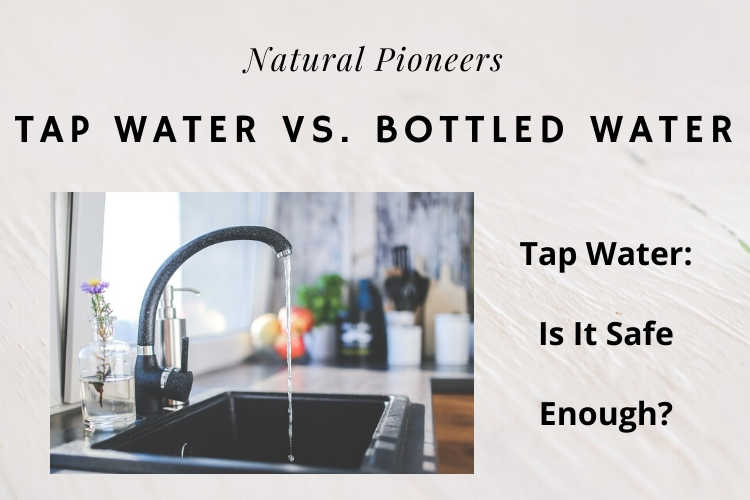
On most government websites you can read something along the lines of:
“The United States is fortunate to have one of the safest public drinking water supplies in the world.” [1]
Now, is that true? Sure. Given the choice, I would much rather have US tap water in my sink than the tap water of some developing country.
I feel blessed and grateful for living in a first-world country that has rules and regulations for the water that comes out my tap.
Among the Natural Pioneers Community however, we aim to eat and drink the very best quality out there while still being conscious about the cost aspect.
Will tap water then fit our requirement for the healthiest water out there? No, it certainly won’t.
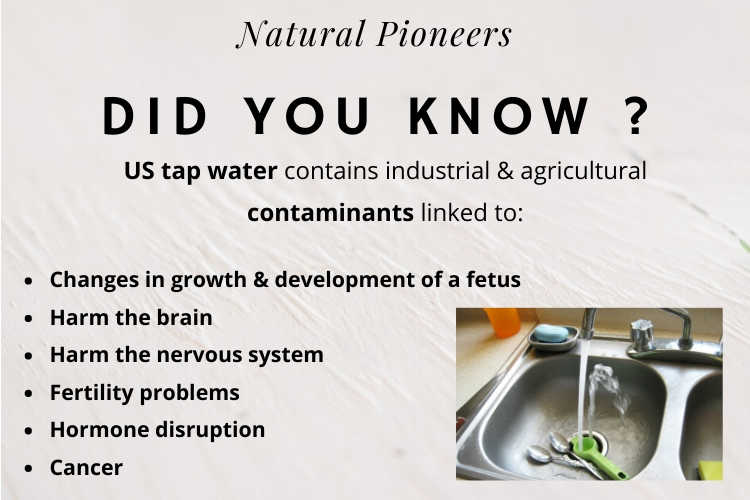
The EWG’s (Environmental Working Group) Tap Water Database collects data from nearly 50,000 local utilities in 50 states.
And here’s the result of just one of the studies they’ve conducted:
Tap water is said to be safe but recent studies raise cause for concern. The disturbing truth; when most Americans drink a glass of tap water, they’re also getting a dose of industrial or agricultural contaminants linked to cancer, harm to the brain and nervous system, changes in the growth and development of the fetus, fertility problems and/or hormone disruption. [2]
Moreover, medical professionals have all reason to provide people vulnerable to infections with boiled or bottled water. The contaminants are just too much for a system in frail health:
“It’s important to note that some people are more vulnerable to getting sick from contaminants in drinking water. You may be in this group if you are undergoing chemotherapy, living with HIV/AIDS or have received a transplant. Pregnant women, older adults and children also may be at greater risk.” [3]
Says Katherine Zeratsky, R.D., L.D., at Mayo Clinic
Conclusion: Tap water is safe enough to be a source of hydration for people who cannot afford to purchase safer, healthier, less contaminated options. For anyone who prioritizes their own health and is willing to purchase better drinking water, there are a lot better options out there. Let’s see what they are.

The Health Aspect of Tap Water
Next to the contamination of water that we just covered in “The Safety Of Tap Water”, there is a nutritional component to water, namely the mineral content.
Studies have shown literally numerous (!) times that the composition of water from a medical point of view depends on the contained amount of minerals and trace elements. [4], [5], [6], [7], [8]
And tap water definitely does contain some amount of minerals. The main reason why supplemental minerals are added to tap water is that it improves the taste. The more tasty it is, the more likely it is for the public to use it as a source of hydration.
To be clear here, from a mineral standpoint, there are worse options than tap water. Bottled water that says “purified”, “distilled”, “remineralized”, “artesian”, “flavored”, or “nutrient-enriched” all contain considerably smaller amounts of minerals. [9], [10]
By way of example, purified waters contain a negligible calcium concentration. Filtration was found to remove a considerable amount of calcium from the water, removing 89% on average. [11]
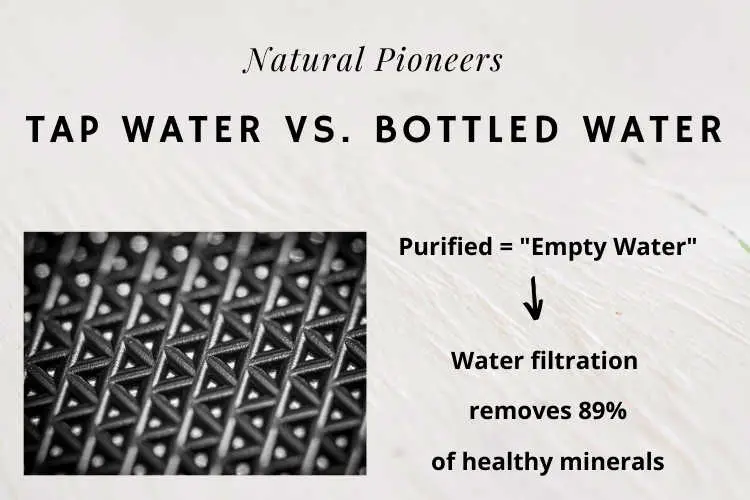
How much calcium and magnesium is in my tap water, you ask?
We did a full comparison for all US tap water mineral data available in studies. Here’s what we found:
Indianapolis, IN, showed the highest amount of minerals in tap water.
85 mg of calcium and 40 mg of magnesium per liter. This translates to 4 glasses containing 10% of your daily requirements of each, calcium and magnesium.
For more information on mineral contents in data, check out our article: Best 18 US Tap Water Cities | Highest In Calcium & Magnesium
Impressive you think?
Compare this to the mineral amount of a European bottled water:
Vittel Hépar mineral water from France contains 575 mg of calcium and 118 mg of magnesium per 4 glasses. The amount of minerals is more than 5x greater than that of tap water. 4 glasses of mineral water contain about 58 % of daily calcium and 30 % of daily magnesium.
I believe by now we’re speaking the same language. If you’re a relentless health idealist like most Natural Pioneers, you know that natural mineral water is the way to go.
Conclusion: The higher the amount of minerals in drinking water, the more healthy it is. The mineral amount in tap water varies. Indianapolis, IN, shows one of the highest concentrations and provides us with a healthy dose 10% of calcium and magnesium per 4 glasses. However, there are mineral waters on the market with considerably higher amounts of minerals.
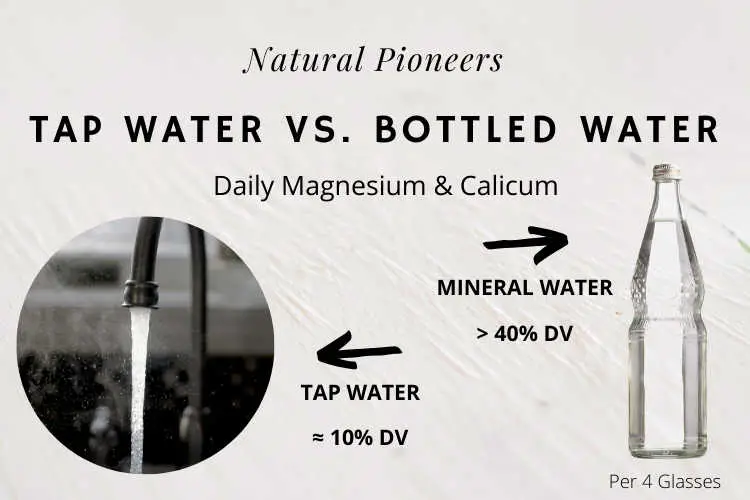
The Taste Of Tap Water
Drinking water, tap and bottled, has been replacing sugar-sweetened beverages in the US diet over the past 5 years. [12]
While that’s a great development, we doubt that this trend is a consequence of the amazing taste of water over soda. And still, there are significant differences in the taste of water.
What makes water taste good?
Studies show that water high in calcium, magnesium, sulfate and bicarbonate tastes best to most people. [13] Bicarbonate is the main alkaline factor in water.
As we covered in the last chapter, both bottled (spring and mineral) water as well as tap water contain minerals. As a consequence tap water has a better taste than bottled water that says “purified”, “distilled”, “remineralized”, “artesian”, “flavored”, or “nutrient-enriched” since they all contain considerably smaller amounts of minerals. [14], [15]
However, since the amount of minerals in tap water is still substantially smaller than that of mineral and spring waters, the taste of those bottled water types might taste even better.
Conclusion: Water high in minerals tastes best to most people. Tap water has a better taste than bottled water that says “purified”, “distilled”, “remineralized”, “artesian”, “flavored”, or “nutrient-enriched”. Bottled spring and mineral waters might still beat the taste of tap water in most cases.
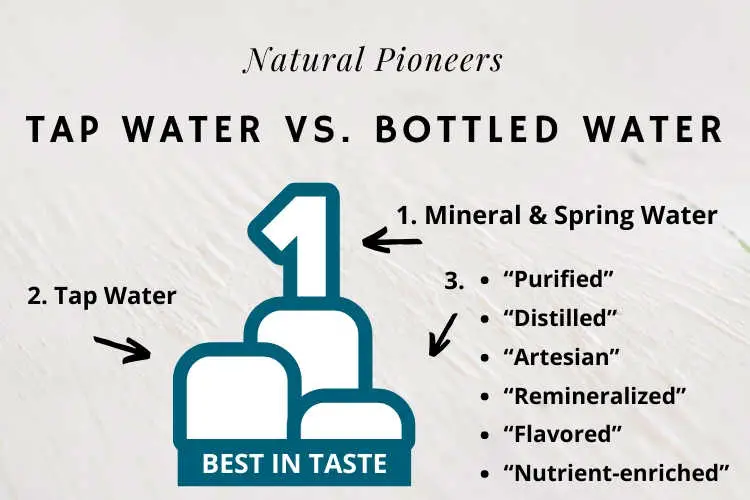
2. Bottled Water: Safe, Healthy, and Tasty?
The Safety Of Bottled Water
Bottled water has a considerably smaller amount of contaminants. Even the less nutritious, like low-mineral waters like “purified”, “distilled”, “remineralized”, “artesian”, “flavored”, or “nutrient-enriched”, have been filtered or purified. [16], [17]
While a purification process like reverse-osmosis eliminates the contaminants, it also clears out all healthy minerals in natural water.
Is bottled water safer? Yes. Most bottled water has been purified and is free from industrial or agricultural contaminants. Purified bottled water is “empty water” with no minerals left – unless you chose naturally high-mineral options like spring or mineral water.
If you’ve read the above chapters, you know that we’re definitely not looking for purified water when aiming to make the best decision for our health. We’re looking for clean AND high-mineral water which nature provides us with through natural springs, wells or even glaciers.
Conclusion: Bottled water can be considered safer than tap water. Purification processes eliminate contaminants in water which makes it safe even for more vulnerable people (undergoing chemotherapy, HIV, pregnant women, etc.). For health conscious people, water high in minerals like spring and mineral water are the safe and more nutritious option.
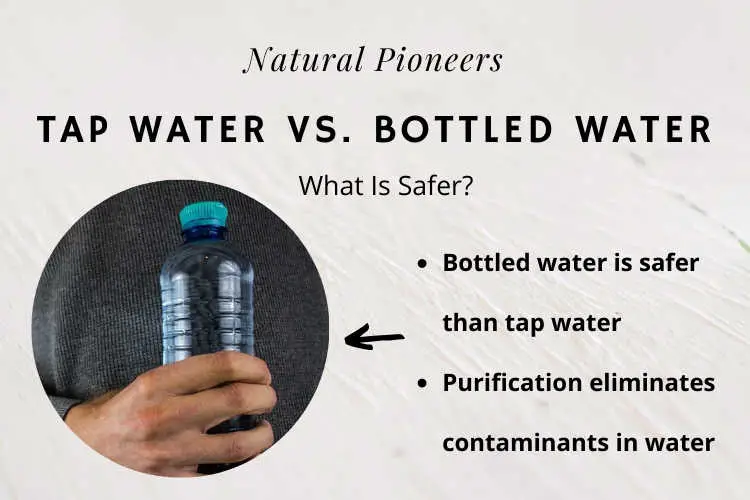
The Health Aspect of Bottled Water
We’ve stressed it enough up to this point: spring and mineral water are your healthiest choices when buying bottled water.
Let’s take a look at the health benefits of spring and mineral water:
- Spring and mineral water contain high levels of calcium and magnesium. Mineral waters may provide over 40% of the recommended daily intake for calcium. Drinking those waters helps achieve an adequate daily intake of those minerals. [18], [19], [20], [21]
- Many studies show that higher-magnesium water is related to decreased risks for cardiovascular disease, especially for sudden death from cardiovascular disease. [22]
- Water low in magnesium may be associated with a higher risk of motor neuronal disease, pregnancy disorders, sudden death in infants, and some types of cancer. [23]
- Water low in calcium is associated with a higher risk of fracture in children, certain neurodegenerative diseases, pre-term birth and low weight at birth and some types of cancer. [24]
- Minerals in spring and mineral water can easily be absorbed. The bioavailability of minerals from mineral water is good and can be compared with that of milk. [25], [26], [27], [28], [29]
- Spring and mineral water area calorie free source of minerals. [30]
- Spring and mineral water help keep our bones healthy. [31], [32], [33], [34]
- Water high in minerals may be useful in the treatment of osteoporosis.[35]
- Especially in aged people with lactose intolerance, mineral waters are recommended to achieve optimal calcium requirements. [36]
- A one-month intake of mineral water rich in calcium, magnesium bicarbonate, and sulfate decreased cholesterol and LDL levels dyslipidemic adults. [37]
- Mineral water intake reduces blood pressure among subjects with low urinary magnesium and calcium levels. [38]
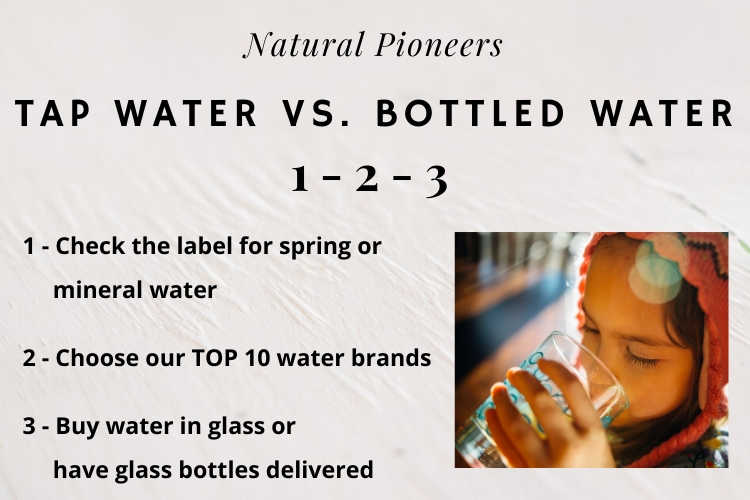
So, how do you make sure you get the very best water for your home?
Here’s the 3 things to look for:
#1: You’re label should clearly say: Natural spring or natural mineral water
#2: Ideally, pick one of these brands:
- Vichy Springs, CA
- Canada Geese, Canada
- Utopia, TX
- La Croix, WI
- Lithia Springs, CA
- Naya, Canada
- Mountain Valley, AR
- Zephyrhills, FL
- Montclair, Canada
- Pure Spring Water, GA
Why these brands, you ask? We @NaturalPioneers compared the mineral content of more than 70 popular bottled waters. The above list shows our top 10 highest mineral waters.
Check out the complete ranking of popular high-mineral bottled waters in our article: Healthy Bottled Water Brands: Best 30 In Calcium & Magnesium
#3: Buy your water in glass bottles or have glass bottles delivered to your home/office
You probably already guessed it, yes, this is where it gets a little more pricey.
While contamination through plastics is too big of a topic to go into the details, here’s what you need to know:
Plastic bottles are a common endocrine disruptor. Plastic bottles and their residue in water they carry interfere with our hormone system. Especially PET bottles should be avoided since they show high estrogenic activity. [39]
Putting the finger on the problem, here’s what harm plastic bottles can cause:
- Reductions in male fertility & declines in the numbers of males born
- Abnormalities in male reproductive organs
- Fertility problems in females and early puberty
- Increases in mammary, ovarian, and prostate cancers
- Increases in immune and autoimmune diseases, and some neurodegenerative diseases [40]
Still with me?
Of course, we’ve researched the pricing of water in glass bottles because – well, because we like you 😉
Here’s our article about water delivery services which compares glass and plastic bottle delivery in LA. Prices can be used as a reference for any other city. Best Water Delivery In Los Angeles | Glass Bottles & Prices
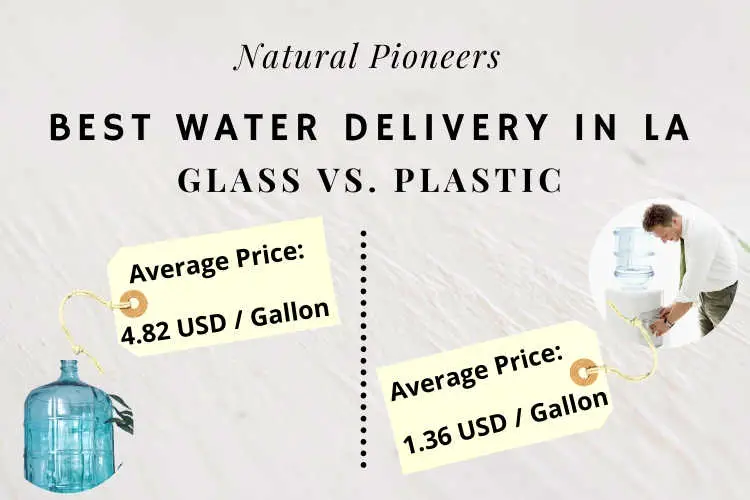
The Taste Of Bottled Water
In “The Taste Of Tap Water”, we’ve already pointed out what water tastes best: Water high in calcium, magnesium, sulfate and bicarbonate tastes best to most people. [41]
High mineral water, like spring or mineral water, contain superior amounts of good-tasting minerals. As a consequence, high-mineral bottled water tastes better than tap water which in turn tastes better than low-mineral options such as “purified”, “distilled”, “remineralized”, “artesian”, “flavored”, or “nutrient-enriched” water.
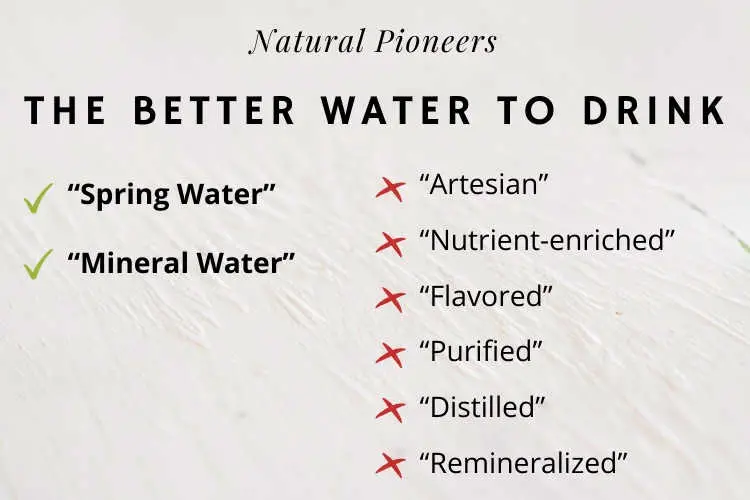
3. Conclusion
What water is more safe?
- Bottled water can be considered safer than tap water. The amount of contaminants is considerably smaller than the one of tap water.
- Bottled water either comes from protected springs or wells or has been purified through processes like reverse osmosis.
What water is healthier?
- The amount of minerals in water is what makes it nutritious or, in other words, more healthy. Some tap waters contain up to 10% of our recommended daily calcium and magnesium (4 glasses). Bottled spring and mineral water contain up to 23% of our daily requirements for calcium and magnesium.
- Both, tap and spring/mineral waters are significantly more nutritious than purified waters labeled “purified”, “distilled”, “remineralized”, “artesian”, “flavored”, or “nutrient-enriched” water.
What water tastes better?
- Water high in minerals tastes best to most people. High mineral water, like spring or mineral water, contain superior amounts of good-tasting minerals.
- As a consequence, high-mineral bottled water tastes better than tap water, while tap water tastes better than low-mineral options such as “purified”, “distilled”, “remineralized”, “artesian”, “flavored”, or “nutrient-enriched” water.
